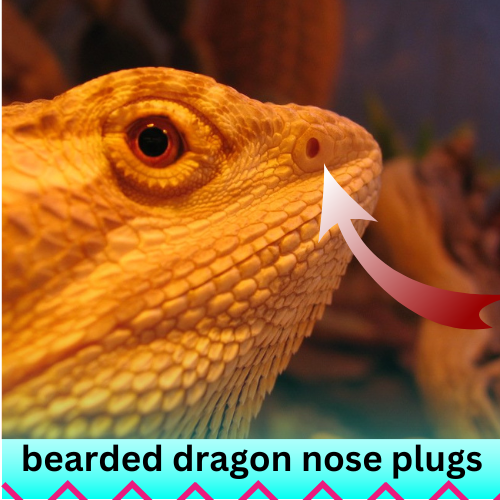Have you ever wondered why bearded dragons have plugs in their noses or what purpose they serve for the creature? It’s a question many people have, especially those who own or consider owning these delightful reptiles. To gain insight into this curious phenomenon, let’s take a closer look at how nose plugs came to be and what benefits they offer bearded dragons.

Why do bearded dragons have nose plugs?
Bearded dragons, also known as Pogona vitticeps, are lizards originating from Australia and have become popular pets for their friendly personalities. One peculiar feature of this species is the presence of nose plugs.
What is a nose plugs in bearded dragons?
Nose plugs are an essential part of bearded dragon care. They act as a physical barrier to prevent foreign particles from entering the nasal and respiratory tract of the reptile. These plugs can be made from various materials, such as medical-grade silicone, rubber, or acrylic. The most effective plug fits snugly into the nostril and completely blocks off the entrance, preventing anything from entering. It is vital to ensure that the plug fits appropriately and does not cause discomfort to your bearded dragon. Additionally, regular cleaning and maintenance of nose plugs can help prevent any dust or dirt buildup which could lead to infection.
1. Protection from Dust and Debris:
The primary purpose of nose plugs in bearded dragons is to protect them from dust and debris particles. Bearded Dragons inhabit desert-like environments with dry air, which can be very uncomfortable for their delicate respiratory systems due to the high levels of dust and dirt in the air. The presence of nose plugs helps to keep out particles that could get trapped inside their noses, thus preventing any breathing difficulties or irritation.
2. Improved Breathing Ability:
Another reason bearded dragons have nose plugs is to improve their breathing ability. The nose of a bearded dragon consists of two nostrils that open up into the nasal cavity; however, due to the size and shape of these nostrils, air can only enter in one direction (inhalation). The nose plugs’ presence helps create an airtight seal between the nasal cavity and the outside environment, thus allowing air to flow freely in both directions (inhaling and exhaling) with ease. This improved breathing ability makes it easier for them to be active and explore their surroundings without difficulty or discomfort.
3. Thermoregulation:
Finally, another critical role that nose plugs play in bearded dragons is thermoregulation. As desert dwellers, beardies must regulate their body temperature to survive and thrive. The nose plugs help keep the air inside the nasal cavity, thus helping them maintain a comfortable body temperature even when outside temperatures drop.
Overall, it is clear that nose plugs play an essential role in bearded dragons’ health and well-being. They protect from dust and debris particles, improve their breathing ability, and aid in thermoregulation.
How to remove the bearded dragon nose plug?
Bearded dragons have small, absorbent nose plugs that can become impacted or blocked. Removing the plug is essential to help your pet breathe easier and stay healthy. Here’s what you need to know about removing a bearded dragon nose plug.
1. Preparing for Removal:
Before attempting to remove the nose plug, it’s essential to make sure you have all the necessary supplies: warm water, a shallow container, cotton swabs, and a soft-bristled toothbrush. Ensuring the area is well-lit, and your pet is comfortable is also essential.
2. Removing the Nose Plug:
Once everything is ready, take a few drops of warm water and saturate the impacted area (this should be done slowly). Then use cotton swabs to dislodge any debris around the affected area gently. Once most of the particles have been removed, take a soft-bristled toothbrush and brush away the remaining material around the plug. Do this until you can see the plug.
3. Final Steps:
You’ll want to take more drops of warm water and saturate the area again. This should help loosen any remaining debris from around the nose plug. Finally, use your fingers or tweezers (if necessary) to carefully pull out the plug. Remember to be gentle during this step – it’s essential not to cause harm or discomfort to your pet.
4. Aftercare:
Once the nose plug has been removed, keep an eye on your bearded dragon for any signs of discomfort or infection. If there is any redness or swelling in the area, contact a veterinarian immediately for further advice and treatment. Additionally, ensure your pet drinks plenty of water and eats a nutritious diet.
Conclusion:
The main takeaway from this article is that bearded dragons use nose plugs for various reasons. Although the exact reason why they have them is still unclear, they are used to help during burrowing or swimming activities to keep debris and water out of the nostrils. They also could be used as a protection mechanism against bacteria and other pathogens when the beardie is exploring its environment. As living creatures adapt to their habitats and surroundings, they often develop unique features that allow them to remain healthy and thrive.
